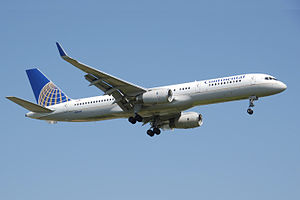Strong headwinds have led to sharp increase in the number of transatlantic Continental Airlines flights forced to make unscheduled stops to refuel, the Wall Street Journal reports. The airline, owned by United Continental Holdings, has pushed the envelope by aggressively using the Boeing 757 on transatlantic flights. The plane is smaller and cheaper to operate than models traditionally used on such flights, but flies at the limit of its range, forcing refueling stops under adverse conditions.
In December, 4%, or 43 of 1100 flights were forced to make unscheduled stops, more than triple last December’s number.
A United spokesman said the company has been offering compensation as a gesture of good will in situations where customers’ experiences warrant it.
Remote Canadian fields at Gander and Goose Bay are the primary places to top off the tanks, but United confirmed that some of its 757 jets were also diverted to Iceland; Ireland; Nova Scotia; Albany, N.Y.; and Stewart International Airport, 60 miles north of Manhattan.
“Headwinds returning from Europe are more extreme than we have seen in 10 years,” said a United spokeswoman. For the past decade, December headwinds averaged 30 knots, according to United data. But last month, the winds averaged 47 knots, and, on the worst 15 days of the month, 60 knots.
The winds didn’t abate this month. In the first eight days of January, United said it made unplanned refueling stops on 14 flights on the six routes most prone to refueling, including four on the Stuttgart-Newark run, four on Paris-Washington Dulles and two each on Stockholm-Newark and Barcelona-Newark. Those routes tend to be nearly as long as the plane’s maximum range.
For remote airports such as Goose Bay and Gander, which have been largely bypassed in recent years by jetliners’ longer range capabilities, fueling stops can bring in tens of thousands of dollars in landing fees and other revenue a month.
Other airlines have had to make unscheduled stops as well, but none has been as aggressive its utilization of undersized aircraft for these flight under these conditions. This is not the first time Continental has come under scrutiny for its use of 757s.
Continental’s enthusiasm for the 757 came under scrutiny four years ago when federal officials determined the carrier was responsible for nearly two-thirds of all the minimum fuel or fuel-emergency incidents reported annually by airliners landing in Newark. There were minimum fuel issues on 23 flights arriving from Barcelona over the course of a single year. When pilots make those calls, air traffic controllers give them landing priority. The Transportation Department’s inspector general didn’t find any safety violations, however.
At what point will Continental’s refusal to use appropriate equipment on its transatlantic flights lead customers elsewhere?
Related articles
- More transatlantic flights forced by wind to land for fuel (cbc.ca)
- When Is a Nonstop Flight Not Really a Nonstop Flight? (cntraveler.com)

